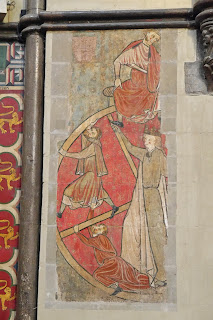Rochester Castle
I have been meaning to visit Rochester since I read the sad tale of its loss of city status. It had been a city since 1211, but ceased to officially be one because of an administrative oversight. The former Rochester-upon-Medway City Council neglected to appoint ceremonial Charter Trustees when Medway became a unitary authority in 1998. Unfamiliar with the archaic rules governing city status, they did not realize that Charter Trustees would be needed to protect the city's status. Consequently Rochester was removed from the Lord Chancellor's official list of UK cities. There does not seem to be a route back.
I started my walk at the railway station and turned right into quiet upper part of the High St. Crossing Station Hill, you enter the more characterful and livelier part and soon pass a section of town wall on the right and a handsome half-timbered house on the left.
A little further along on the right is La Providence. This was originally founded in the City of London in 1718 as a hospital for Huguenot refugees and later relocated to Hackney. It was further relocated in 1959 when this pleasant square of early Victorian houses was acquired and refitted as sheltered accommodation for elderly people of Huguenot descent. It is perhaps slightly surprising that such people can still be readily identified.
Next is a more conventional almshouse, Watts's Charity, the Poor Travellers House, endowed by the will of Richard Watts in 1579 to provide a night's lodging for six poor travellers. It apparently continued in this role until the Second World War.
Then the narrow street suddenly opens out on the left hand side to offer a great view of the Norman cathedral, begun in 1080 on the site of a Saxon cathedral dating from 604. It claims to be the second oldest in the country (I think Durham is the oldest).
Continuing along the High S, you come to the old Corn Exchange, with its large clock. Unfortunately, it is currently concealed behind scaffolding.
Continuing along the High St towards the river Medway, you come to the imposing Guildhall of 1687 - it too was hidden behind scaffolding. Turning left at the, you approach the keep of the Norman castle. This is the tallest one in the country (113 feet high) and was started in 1127.
Circling round the perimeter of the keep (you can visit, but I did not have time today), you come out in front of the cathedral, with its magnificent facade and dramatic silhouette.
Inside, the nave has classic Norman round arches with geometrical patterns above them.
In the choir there is a lovely fragment of a medieval wall painting.
As you emerge from the west door, there is a great view across to the Castle, indicating how large the surrounding walls were (this is the photo at the head of this post. Turning left and left again into St Margaret's St, there is a view of the 15th century Prior's gate, the most compelte of the three gates to the cathedral close.
I walked along St Margaret's St in search of some of Rochester's lesser-known sights, its fine almshouses. On the right, is this imposing building of 1724, once a workhouse (a relatively early example) and school, and now part of King's School.
At the top of the hill, a delightful terrace of three houses had beautiful art nouveau floral decorations above the windows.
Further on I came upon this splendid fortification, Fort Clarence. It was built between 1808 and 1812 to defend Rochester from land attack or river landing and originally stretched from Maidstone Rd to the River Medway. Some parts of the structure were demolished in the 1930s and again in the 1960s. It is now apartments.
Now along Borstal Road and left into Priestfields to reach Foord's Almshouses of 1927, by the architect E Guy Dawber. This is an impressive, large group in a very traditional style for the date.
At the end of Priestfields, I turned left into Maidstone Rd, now heading back towards the town centre, and found Watts' Almshouses of 1858 on the left. This is a long and ornate terrace, set back from the road, with an extrordinary building in the centre. The invaluable Images of England website descibes it as "a good example of vigorous, studiedly detailed, mid-Victorian C17 domestic revival architecture".
It remained only to plod back to the station.
Conditions: a really nice, bright day.
Distance: about 6 miles.
Rating: five stars.































